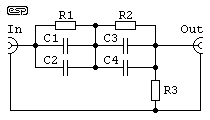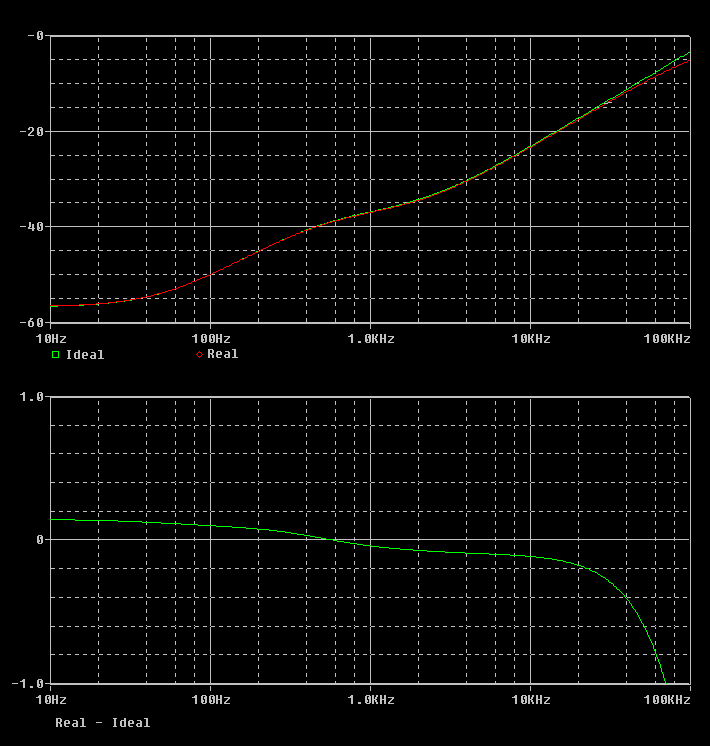Что-то не так?
Пожалуйста, отключите Adblock.
Портал QRZ.RU существует только за счет рекламы, поэтому мы были бы Вам благодарны если Вы внесете сайт в список исключений. Мы стараемся размещать только релевантную рекламу, которая будет интересна не только рекламодателям, но и нашим читателям. Отключив Adblock, вы поможете не только нам, но и себе. Спасибо.
Как добавить наш сайт в исключения AdBlockРеклама
Reverse RIAA Equaliser
Introduction
I came up with this idea when I was in a situation where ...
| I was missing another input for a standard audio signal at this amplifier. |
So I designed a miniature passive network to convert a normal audio signal into the signal that phono inputs require.
Description
As the amplification of a phono input is quite high, this pre-equaliser network can be made completely passive. The frequency response of the current through the network formed by R1, R2, C1 - C4 corresponds to the inverse of the standard RIAA curve, so these components determine the frequency response of the circuit. The current produces a proportional voltage across the operating resistor R3. This resistor determines the output voltage or the overall voltage gain. I selected it so that with my amplifier the standard (DIN) inputs show the same sensitivity as the phono input with this adapter.

Figure 1 - Reverse RIAA Filter
R3 influences the frequency response at the upper end. If R3 becomes too high, high frequencies are reduced. With R3 = 1.5k the reduction is less than 0.1dB @ 20kHz, with 10k it's about 3dB.
The capacitance of the RIAA input up to 50pF or
more is negligible. Source resistances up to 1k will also have little effect,
and this fits well to low resistance cinch or headphone outputs.
| Ideal | Actual | Alternative | |
| R1 | 883k | 909k | 910k |
| R2 | 75k | 78.7k | 75k |
| C1 | 3.6n | 3.3n | 3.3n |
| C2 | - | 180p | 270p |
| C3 | 1n | 680p | 1n |
| C4 | - | 270p | - |
| R3 | 0 | 1.48k | 1 - 1.5k |
The ideal frequency response cannot directly be achieved by standard components. It must be approximated and in this case the approximation is improved by paralleling two capacitors each. In the table you find ideal and practical values for all components. The resulting frequency response and the difference to the ideal frequency response is shown in the plot.
Use of the alternative values shown will result in an almost negligible error, and these are standard E24 series components (ED)
Components were selected from the E96 series for resistors and the E6 series for capacitors. Of course all values may be different, but their relations to each other must be as close as possible to the ones in the ideal circuit.

Figure 2 - Frequency Response
In the upper plot the frequency response of the ideal and the real circuit is shown, in the lower one the difference between both.
The All-In-One-Plug-Solution
My personal aim was to build the whole circuit stereo into one DIN connector. This is why I chose a circuit with all elements (except R3) tied together at one centre point. So I could build the element building block shown in the photo from 0805-SMD-components. Two of these fit easily into one DIN connector together with twice R3 (see photo), but a single circuit surely would fit into a cinch plug as well.
Editor's Notes
Although Uwe designed this circuit to utilise an otherwise unused phono input, it can also be used to test phono stages for frequency response. By feeding a high level (1V RMS) signal into the circuit, a quick check of the response of any phono preamp is easily done. The combined response should be flat within 1dB - if not, the phono equaliser is not accurate.
Most readers will build this circuit using conventional resistors and capacitors, and this is perfectly OK to do. The values need to be as close as possible to the values calculated by Uwe (or the alternative values I included), or overall performance will be adversely affected.

Figure 5 - Reverse RIAA and P06 Phono Preamp
Figure 5 shows the combined response with Uwe's reverse RIAA equaliser and my (favourite) phono preamp - Project 06. The slight boost in bass and negligible boost in treble is seen easily - these account (in part) for the very favourable comments about this phono preamp, and also show how accurate it is. The inaccuracy is shown to be better than 1dB at most frequencies, but with a very slight improvement in lower bass. The inaccuracies indicated here are very minor, and are especially so when compared to the wide variations in the mix quality of typical vinyl recordings (actually, any recording, regardless of medium). A CD player could easily be used with this combination, and the only penalty (in realistic terms) would be a slightly higher noise level - you would be able to hear hiss at a metre away, instead of having to stick the tweeter in your ear :-)